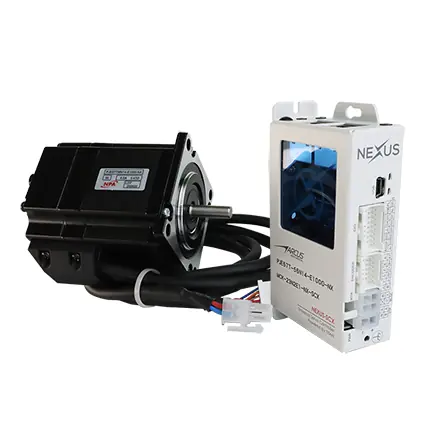Closing the Loop: Stepper Motors Operating in Servo Mode
Running a stepper motor in servo mode is a bit of a new thing. In the past, when talking about utilizing rotary servo motion, that meant using a brushless servo motor; however, if you have an encoder with sufficient resolution and a servo driver, you can control a rotary stepper motor to achieve the same motion profile. In this article, we will review what it means to operate a stepper open loop and discuss why it is sometimes beneficial to break with habit to operate in closed loop.
If you have a stepper motor with an encoder, you can operate it using a servo controller. Doing this allows the stepper to operate as if it is a brushless servo motor, providing a similar motion profile with some additional benefits, as a cheaper option (as the magnetized iron plates required to operate stepper motors are not as expensive or powerful as those magnets in brushless servo motors).
Open Loop
A stepper motor is controlled by pulse and direction and can run open loop (meaning without any feedback). Depending on the application, it may be perfectly fine to operate a stepper motor open loop, and still provide high levels of accuracy. However, in situations where there may be torque disturbances, an open loop stepper operation can lose steps or stall. By adding an encoder for feedback, you close the loop – the motor is still operated with a pulse and direction command, but the encoder allows the controller to evaluate feedback and adjust the pulse rate to match the position of the encoder. So closing the stepper feedback loop is a lot like … creating a servo.
Stepper vs. BLDC
Stepper motors run much quieter in servo mode, and are more efficient, as they operate based on the demand of the current, allowing the system to operate much cooler than one that requires full current 100 percent of the time.
There are applications better suited for a brushless servo rather than a stepper motor due to the speed torque characteristics of the step motor and inertia mismatch issues. If these are a concern, a true servo will be more appropriate.
A universal servo controller, which can operate both kinds of motors, has the ability to provide pulse and direction, and can control a stepper motor with encoder feedback (though not all controllers have the control algorithms to achieve this).
SmartPak and PulsePak featuring Nexus Controller
The Nexus motion controller is a universal servo controller that has the features to operate several different styles of motors in true servo mode: controlling the motor position in real time, while it is moving, adjusting to the motion profile given. Nexus is a pulse and direction servo driver that provides closed-loop control. This small, advanced controller is simple but intelligent, powerful and intuitive.
Nippon Pulse offers the SmartPak and PulsePak pre-packaged motion control kits, which will feature a Nexus controller and a bipolar rotary hybrid stepper motor with an encoder, to get your application up and running quickly. The kits are ideal for use in a wide variety of applications, including lab automation, semiconductor manufacturing and food processing, and the Nexus controller is compatible with 2- and 3-phase stepper and servo motors, brushed and brushless motors, and voice coil motors.
Nippon Pulse offers the SmartPak and PulsePak pre-packaged motion control kits, which will feature a Nexus controller and a bipolar rotary hybrid stepper motor with an encoder, to get your application up and running quickly. The kits are ideal for use in a wide variety of applications, including lab automation, semiconductor manufacturing and food processing, and the Nexus controller is compatible with 2- and 3-phase stepper and servo motors, brushed and brushless motors, and voice coil motors.
For more information about the SmartPak and PulsePak solutions, click here.


